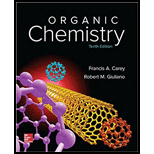
Interpretation
The structure for the derivative of divinylcyclopropane including its stereochemistry is to be deduced.
Concept introduction:
>Reactions of dienes that proceed in a single step by way of cyclic transition state are called pericyclic reactions.
>Compounds having
Cope rearrangement is a type of pericyclic reaction in which one
The reactant molecule must have two isolated double bonds at
The reaction must pass through a cyclic transition state to produce two cis double bonds in the ring.
>The product of the Cope rearrangement has double bonds at
Want to see the full answer?
Check out a sample textbook solution
Chapter 11 Solutions
ORGANIC CHEMISTRY (LOOSELEAF)-PACKAGE
- -Ocimene is a pleasant-smelling hydrocarbon found in the leaves of certain herbs. It has the molecular formula C10H16 and a UV absorption maximum at 232 nm. On hydrogenation with a palladium catalyst, 2,6-dimethyloctane is obtained. Ozonolysis of -ocimene, followed by treatment with zinc and acetic acid, produces the following four fragments: (a) How many double bonds does -ocimene have? (b) Is -ocimene conjugated or nonconjugated? (c) Propose a structure for -ocimene. (d) Write the reactions, showing starting material and products.arrow_forwardFriedel–Crafts alkylation of benzene with (R)-2-chlorobutane and AlCl3 affords sec-butylbenzene. How many stereogenic centers are present in the product?arrow_forwardThe endiandric acids comprise a group of unsaturated carboxylic acidsisolated from a tree that grows in the rainforests of eastern Australia.The methyl esters of endiandric acids D and E have been prepared frompolyene Y by a series of two successive electrocyclic reactions: thermalring closure of the conjugated tetraene followed by ring closure of theresulting conjugated triene. (a) Draw the structures (includingstereochemistry) of the methyl esters of endiandric acids D and E. (b)The methyl ester of endiandric acid E undergoes an intramolecular [4 +2] cycloaddition to form the methyl ester of endiandric acid A. Propose apossible structure for endiandric acid A.arrow_forward
- Account for the stereoselectivity and regioselectivity of the three steps in the conversion of compound C to compound F.arrow_forwardFriedel–Crafts alkylation of benzene with (R)-2-chlorobutane and AlCl3 affords sec-butylbenzene. Would you expect the product to exhibit optical activity? Explain, with reference to the mechanism.arrow_forwardBrevicomin, the aggregation pheromone of the western pine bark beetle, contains a bicyclic bridged ring system and is prepared by the acidcatalyzed cyclization of 6,7-dihydroxy-nonan-2-one. a. Suggest a structure for brevicomin. b. Devise a synthesis of 6,7-dihydroxynonan-2-one from 6-bromohexan-2- one. You may also use three-carbon alcohols and any required organic or inorganic reagents.arrow_forward
- The last step in the synthesis of β-vetivone, a major constituent of vetiver, a perennial grass found in tropical and subtropical regions of the world, involves treatment of C with CH3Li to form an intermediate X, which forms β-vetivone with aqueous acid. Identify the structure of X and draw a mechanism for converting X to β-vetivone.arrow_forwardCompound A (C9H12) absorbed 3 equivalents of H2 on catalytic reduction over apalladium catalyst to give B (C9H18). On ozonolysis, compound A produced 3 products, C, Dand E which was a ketone identified as cyclohexanone. On treatment with NaNH2 in NH3,followed by addition of iodomethane, compound A gave new hydrocarbon, F (C10H14). Drawstructures of A, B, C, D and F.arrow_forwardSeveral steps in the synthesis of optically active duloxetine, an antidepressant sold under the trade name Cymbalta, are shown. Identify the structure of intermediates A–C and the final product duloxetine, including stereochemistry, in this reaction sequence.arrow_forward
- - Identify compounds J & K - Draw a curved arrow mechanism that accounts for the formation of J (take into account stereochemical considerations)arrow_forwardWhat is the structure of cis-jasmone, a natural product isolated from jasmine flowers, formed by treatment of alkyne A with H2 in the presence of the Lindlar catalyst?arrow_forwardHow can X be prepared from a constitutional isomer by a series of [2 + 2] cycloaddition reactions? Interest in molecules that contain several cyclobutane rings fused together has been fueled by the discovery of pentacycloanammoxic acid methyl ester, a lipid isolated from the membrane of organelles in the bacterium Candidatus Brocadia anammoxidans. Therole of this unusual natural product is as yet unknown.arrow_forward
 EBK A SMALL SCALE APPROACH TO ORGANIC LChemistryISBN:9781305446021Author:LampmanPublisher:CENGAGE LEARNING - CONSIGNMENT
EBK A SMALL SCALE APPROACH TO ORGANIC LChemistryISBN:9781305446021Author:LampmanPublisher:CENGAGE LEARNING - CONSIGNMENT
 Organic ChemistryChemistryISBN:9781305580350Author:William H. Brown, Brent L. Iverson, Eric Anslyn, Christopher S. FootePublisher:Cengage Learning
Organic ChemistryChemistryISBN:9781305580350Author:William H. Brown, Brent L. Iverson, Eric Anslyn, Christopher S. FootePublisher:Cengage Learning


